
foreword | Historical Narratives | Resources | Links | Contact
THE CAROLINE
History shapes the world in which we live.
The bankruptcy of Britain's Barings Bank a few years ago shocked the financial world. Founded in 1763 the bank and its owners played an important role in the history of Britain, Canada and the United States. Sir Francis Baring, the institution's principal owner, was an advisor to British Prime Minister William Pitt who rewarded Francis with a baronetcy in gratitude for his successful management of theEast India Company. Baring's Bank helped fund Britain's fight against Napoleon and revolutionary France and in 1803 the bank assisted the United States of America to finance the Louisiana Purchase [*] from Napoleon.
On the death of Francis leadership of the firm passed to his second son, Alexander, who is better known to Canadian history as Lord Ashburton. It was not as a banker but as a commissioner that Lord Ashburton assisted with the settlement of an international incident involving Canada and the United States in 1842. The incident that caused the crisis is known in history as The Caroline Affair. The Caroline was a 46-ton, copper-bottomed steamship owned by William Wells a resident of Buffalo. The vessel normally sailed between Buffalo and Schlosser [Niagara Falls, New York].
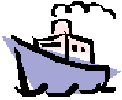 |
|
|
In late December, 1837 the Caroline was cut out of the ice where she had been laid up for the winter and pressed into service ferrying from Schlosser to Navy Island [**]"passengers, freight, etc. with the view of making money." Seventeen American men of means had bonded themselves to prevent Wells from suffering any loss should the Caroline encounter trouble ferrying "freedom fighters" to the little Canadian island.
Following the abortive rebellion in Upper Canada in December 1837, William Lyon Mackenzie with a thousand pound reward on his head made for the border. En route patriots in the province who loved liberty more than loot kept and cared for him as he made his way to the border. Mackenzie crossed the Niagara River in full view of his pursuers who were diverted by the wife and family of the man that rowed him across the river. Once on the other side Mac made for Buffalo where he issued an appeal to the American people for help to make the province of Upper Canada "a free, sovereign and independent state." Some forty-eight residents of Buffalo had pledged their "mutual support and co-operation for the commendable purpose of aiding and assisting our Canadian brethren in their present struggle for liberty."
Mackenzie decided to begin the process by seizing Navy Island in the Niagara River. On the 14th of December he and his compatriots rendezvoused on Grand Island from where in the early hours of the 15th of December 1837 they were transported in scows to Navy Island. They planned to use the island as a base from which to launch an attack and liberate Upper Canada from the "tyrants of Britain."
Mutual hatred existed between the British and the Americans and it burnt brightest along the border. It was exacerbated by many memories and numerous animosities, "particularly on the American side where Negro slaves escaped from the land of liberty and crossed into the land of oppression." American "freedom fighters" said they would willing pledge "their own hearts' blood" for liberty 's cause.
 |
|
|
Navy Island made an excellent fortress. The 144-hectare island some two miles above the Falls was well-wooded and surrounded by nature's mighty moat whose treacherous current could easily carry the unwary to a cascading plunge into the maelstrom. After occupying the island Mackenzie promptly declared the founding of the Provisional Government of the State of Upper Canada.
Mackenzie delivered a proclamation inviting one and all to assist Upper Canadians to overthrow their European overseers.INHABITANTS OF UPPER CANADA!
For nearly fifty years has our country languished under the blighting influence of military despots, strangers from Europe, ruling us, not according to laws of our choice, but by the capricious dictates of their arbitrary power. We are wearied of these oppressions, and resolved to throw off the yoke. Rise, Canadians! Rise as one man, and the glorious object of our wishes is accomplished. We have planted the Standard of Liberty in Canada, for the attainment of the following objects.
- Perpetual Peace;- Civil and Religious Liberty;
- The Abolition of Hereditary Honors;
- A Legislature composed of a Senate and Assembly chosen by the people;
- An Executive to be composed of a Governor and other officers elected by the public voice;
- A Judiciary chosen by the Governor and Senate, and composed of the most learned, honorable, and trustworthy of our citizens;
- Free Trial by Jury-Sheriffs chosen by you;
- Freedom of the press;
- Vote by Ballot-free and peaceful township elections;
- Freedom of Trade every man to be allowed to buy at the cheapest market, and sell at the dearest;
- No man to be compelled to give military service, unless it be his choice;
- A frugal and economical Government, in order that the people may be prosperous and free from difficulty;
- An end forever to the wearisome prayers, supplications, and mockeries attendant upon our connection with the lordlings of the Colonial Office, Downing Street, London;
- Opening of the St. Lawrence to the trade of the world, so that the largest ships might pass up to Lake Superior;
- The distribution of the wild lands of the country to the industry, capital, skill, and enterprise of worthy men of all nations;
For the attainment of these important objects, the patriots now in arms under the Standard of Liberty on NAVY ISLAND, Upper Canada, have established a Provisional Government of our country.
In an open spot on the wooded island Mackenzie raised in the wintry wind the Patriot tricolour, a revolutionary flag bearing twin stars representing Upper and Lower Canada. At the same time the Great Seal was approved featuring a new moon breaking through the darkness bearing the words
"Liberty - Equality."
Mackenzie offered a reward of 500 pounds for bringing Sir Francis Bond Head to justice for his crimes against the people. He then ordered the positioning of gun batteries at each corner of the island facing
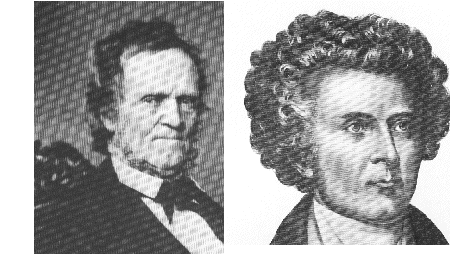 |
|
William Lyon Mackenzie & Sir Francis Bond Head |
the Canadian side. The Caroline was to be the Patriots' lifeline for money, men and supplies. It ferried passengers at 25 cents a head as well as freight that included cannons, ammunition and supplies.
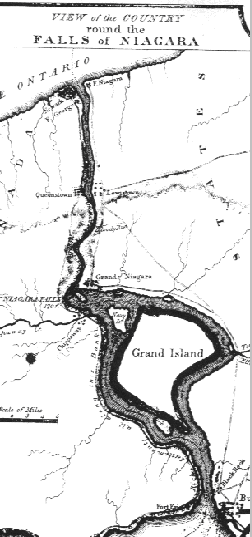 |
|
|
By Christmas time 2500 Upper Canadian militiamen led by Colonel Allan MacNab were encamped along the Canadian shore near Chippawa from where they kept a wary eye on the island. They had been given orders to stand strictly on the defensive and were forced to look on in frustrated outrage as the ragtag, rebel band occupied the Canadian island. They were angrier still that "pirate" Americans were supplying the outlaw renegades with support and sustenance.
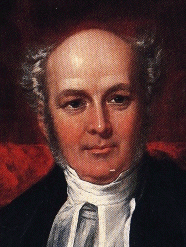 |
|
Sir Allan Napier MacNab |
Various songs opposing the rebellions gained popularity during the years 1838-1840. One of them was titled
A New Song.
When Mackenzie's rebel band was beat
Away from Gallows Hill, ¨ Sir,
To Buffalo he did retreat and said
We had used him ill, Sir.
The Buffalonians did sympathize
And soon began to roar, Sir,
They kicked up such a tarnation noise
It reached the British shore, Sir.
Now Uncle Jonathon be wise
And of yourselves take care, Sir,
For each Canadian loudly cries
"Invade us if you dare," Sir.
The Spirits of our Wolfe and Brock
Do still around us hover,
And still we stand on Queenston Rock
To drive those Yankees over.
No slave shall ever breathe our air,
No Lynch Law e'er shall bind us,
So keep your Yankee mobs at Home,
For Britons still you'll find us.
It was anticipated that once sufficient men and munitions had been conveyed to the island, the rebels would launch an invasion of the mainland. The Canadian militia had been ordered to conduct defensive operations only and not to fire on the island. Upper Canada's Lieutenant-governor, Francis Bond Head, feared any offensive action could lead to complications with the United States. There was also the possibility, of course, that the rebels might defeat the militia, many of the whom could then be carried by the strong current over the Falls, a daunting prospect.
Among those milling about on Navy Island were spies and undercover agents who "kept up a constant stream of intelligence" to MacNab and the Militia. Their reports indicated incessant quarrelling among the "deceived and starving creatures," some two hundred of whom were "constantly prowling up and down the American shore, begging for food, arms and ammunition" and pleading for support for "the holy cause of making the oppressed free." It was noted that "Buffalo bakers were supplying daily bread."
One of the spies was a sixteen year old girl who carried secret dispatches to and from the Patriots. When dressed as a girl, she carried the messages in her stays. When dressed as a boy, she hid them in the lining of her hat. On one occasion when attempting to steal a horse, she was captured and subsequently jailed in Kingston. The English author Charles Dickens visited the jail when he passed through that city in 1842 and recorded that he saw this "beautiful girl of twenty who had been in jail for several years." She had, he wrote, "quite a lovely face though there was a lurking devil in her bright eyes which looked out pretty sharply from between her prison bars."
During the whole of the 29th of December the Caroline continued to pass back and forth ferrying recruits, arms and supplies to the island. MacNab and Commander Drew were watching as a cannon and a number of men were put ashore. The ship was obviously engaged in what could legally be defined as piratical acts. Something had to be done. MacNab decided to act. His decision was motivated in part by the shots and insulting shouts coming from the island which were making the militiamen milling about on shore restless and critical of their enforced inaction. Turning to his naval commander, MacNab exclaimed,"I say Drew, this won't do. Do you think you can cut out that boat?" Drew replied, "Nothing easier but it will have to be done at night."
It was the only order Commander Drew needed. He decided to cut out the Caroline that very night. Sir Francis Bond Head later reported to Lord Glenelg that on Feb. 9, 1838 Drew called for volunteers "who would follow him to the Devil." Seven boats each manned by an officer and eight men armed with cutlasses and pistols rowed cautiously across the river. The attackers expected to see the Caroline close to or tied up at Navy Island. Instead they spotted the lights of the ship docked at a wharf at Schlosser. Although the vessel was in American waters, MacNab's orders had been clear: "Get the Caroline." Drew turned to his men and declared, "The steamboat is our object - follow me." When the seven boats reached the vessel, grappling pikes were thrown over the sides and the men clambered up and onto the Caroline.
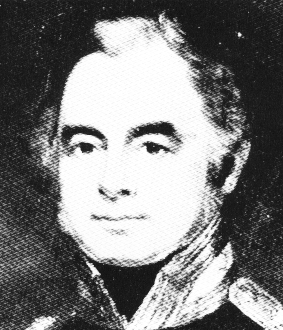 |
|
Sir Allan Napier MacNab |
"Up they came, thick and fast," commented one American afterwards. "Then came the slashing of the cutlass and the sharp bang of the pistol." It was reported that a number were wounded and several killed. Only one body was ever found either at Schlosser or in the Niagara River and that was an American named Amos Durfee, "a musket ball having penetrated the back of his head and come out at the forehead."
The destruction of the Caroline on the American bank of the Niagara River threw the whole frontier area into a frenzy of excitement and fears of invasion were rife. Buffalo citizens made a martyr of Durfee by displaying his body in front of City Hall. An exaggerated account in the Lewiston Gazette headlined: "Horrible! Most Horrible!" stated that "every individual was butchered except four and three were seriously wounded." The New York governor stated in a message to the legislature that "more than a third of the thirty-three persons on board the Caroline were wantonly massacred." Drew reported that five or six men had been killed, but no other deaths were actually proven.
Drew had intended to sail the Caroline back to Chippawa, but they could not get steam up quickly enough so the order was given to "set her ablaze." The fire was started in the ladies' cabin where sheets were doused with oil and lit. The Caroline was cut loose and towed away from the dock. For a moment it became entangled in a bed of rushes then it broke free and commenced her final, flaming trip down river. Her woodwork was rapidly consumed by the hungry flames and the metal pipes "got red hot and stood upright to the last." A witness reported on the splendid sight which shed a light for many miles around. "The rippling water made it appear as if gold dust had been sprinkled on its surface. It was a sight that made the boldest hold his breath" as the flaming Caroline floated down the river.
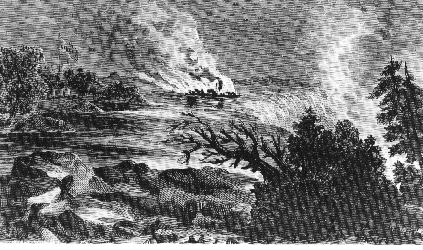 |
|
|
Horrified American crowds lined the river bank as the flaming vessel made its way toward the brink. It was fancifully reported by some that even over the roar of the fire and the Falls they could actually hear the "wail of the wretches as they faced the double horrors of a fate which nothing could avert." American reporters had a field day ranting over the outrage that had taken the lives of American citizens in their own land. The Rochester Democrat piteously posed this maudlin, melodramatic question of its readers:
Who lay as a babe on its mother's breast,
On the shores of its native land?"
Breathed they of fire or of streaming flood,
Or the thundering cataract's whelming flood?
Contrary to the dramatic drawings and the extravagant news reports, the ship did not go over the Falls but broke up in the upper rapids where her engine could be seen for years after. Parts of the ship did eventually drift over the Falls including its figurehead which was picked up near Lewiston and is today displayed in the Museum of Buffalo Historical Society. No person was aboard the doomed vessel.
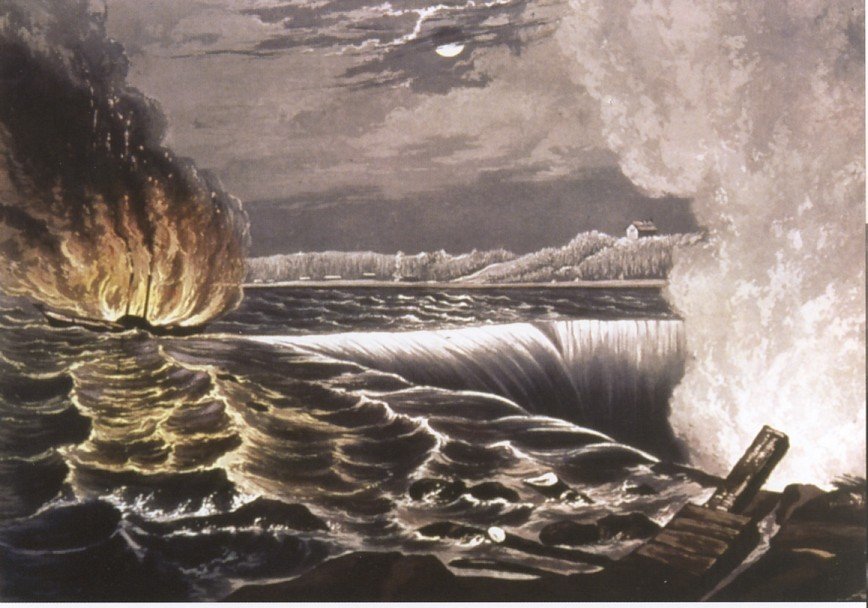 |
|
George Tattersall's Burning Remains of the Caroline about to take the plunge. (In fact, it did not.) |
On the Canadian shore a large crowd had gathered and a huge bonfire provided a big beacon to guide the returning heroes to their homeland. As they came into view the watchers let loose with "three of the heartiest cheers ever given." Later Sir Francis Bond Head described the enterprise as "this act of calm justice and cool vengeance."
 |
|
|
There was nothing cool about the calls for revenge for the daring destruction of the Caroline nearly fired the border as well as the boat. Americans along the frontier were incensed by the death of an American citizen and at the blatant violation of their sovereignty and demanded revenge. Buffalo became an armed camp poised for an attack on Upper Canada. The 'outrage' was described later in a sworn statement by an American commissioner.
"About midnight the Caroline was boarded by some 70 or 80 men all of whom were armed. They immediately commenced a warfare with muskets, swords, and cutlasses upon the defenceless crew and passengers of the Caroline, all the while crying fiercely,'Give them no quarter, kill every man. Fire! Fire!'"
In President Van Buren's report on the episode to Congress he stated, "An outrage of a most aggravated character has been committed accompanied by a hostile though temporary invasion of our territory producing the strongest feelings of resentment on the part of our citizens along the whole border line." The district attorney for Buffalo reported to President Van Buren that "our whole frontier is in commotion and I fear it will be difficult to restrain our citizens from seeking revenge for this flagrant invasion of our country by resort to arms."
Major-General Winfield Scott and militia forces were quickly dispatched to the border by President Van Buren who cautioned the general to maintain the peace "without using the force that has been confided to you." Meanwhile angry Americans residing near the border raged and railed and demanded revenge. Their sense of outrage flickered and flamed for three years before they finally got satisfaction. In 1841 a deputy sheriff of the Niagara District named Alexander McLeod allegedly boasted while in a tavern in Lewiston, New York that he had personally killed Amos Durfee. He was promptly arrested and indicted by a state grand jury for arson and murder.
The British government demanded his release on the grounds that the destruction of the vessel was an authorized military operation and so McLeod could not personally be held responsible. The United States government agreed to accept this interpretation but New York State officials would not, citing their citizens' demand for satisfaction and the cries for war all along the border.
Canadian tempers were also running high and both the people and their politicians demanded that the British government take an aggressive stance with the United States in seeking the release of Alexander McLeod "whatever the consequences." Britain complied and its foreign secretary threatened that if McLeod were convicted and executed his death would be avenged. Newspapers on both sides of the inflamed Niagara District wildly whooped it up. Peace or war rested on the outcome of the trial.
The Attorney General of the United States handled the defence and the military under General Scott were present to protect the prisoner "from popular violence." By the time McLeod's trial finally occurred between October 4th and the 12th, 1841 public interest had turned to apathy and the verdict of acquittal based on an air-tight alibi was greeted almost with indifference.
In August, 1842 Mr. Daniel Webster, the American secretary of state, in a note to Lord Ashburton informed him that a wrong had been done and an offence committed "to the sovereignty and dignity of the United States" for which "no atonement or even apology had been made." Lord Ashburton resolved the Caroline Affair with what was called a diplomatic nicety. While he did not extend a formal apology for the violation of American territory, he did say he regretted "that some explanation and apology for this occurrence was not immediately made."
Alexander McLeod became a storekeeper in Drummondville and unsuccessfully sued the State of New York for false imprisonment. He then made repeated appeals to the British government for some kind of compensation for his starring role in the affair, details of which he fondly and frequently recounted to his customers. He was eventually awarded a pension of 200 pounds and appointed justice of the peace in Welland county. Drew became an admiral,
 |
|
|
Colonel Allan MacNab was made a knight and the Caroline's flag became a treasured relic in the possession of the Toronto Public Library.
Lord Ashburton was sympathetic and supportive of the Amricans and highly critical of Canada. In 1816 his admiration of the Americans led him to state to the American ambassador, "I wish the British Government would give you Canada. It is fit for nothing but to breed quarrels." There were some who believed Lord Ashburton was attempting to accomplish just that a little at a time when he represented Britain in negotiations with the United States over the border between New Brunswick and Maine in 1842. Ashburton was bitterly condemned for sacrificing the interests of Canada in the treaty in which the United States got seven twelfths of the contested territory and Canada five-twelfths. Criticism may have been justified for it was suggested that "if reparations were wanting for the Caroline it found plentiful compensation in the territory gained by the settlement of the northeast boundary-line." Following the settlement Lord Ashburton commented, "The whole territory we were wrangling about was worth nothing."
Lord Ashburton also negotiated the boundary in northern Ontario involving the St. Mary's River thence to the Lake of the Woods. In this instance as well, Ashburton saw fit to grant a considerable portion of the land in question west of Lake Superior to the United States.
[*] NEW ORLEANSOn Saturday December 20, 2003 Americans marked the 200th anniversary of the Louisiana Purchase, which saw France sell 800,000 square miles of land to the Americans for $15 million or about 4 cents per acre. This purchase doubled the size of the United States and the land involved eventually became part or all of the 15 states of Arkansas, Louisiana, Missouri, Iowa, North Dakota, Texas, South Dakota, New Mexico, Nebraska, Kansas, Wyoming, Minnesota, Oklahoma, Colorado and Montana. France had bought the land from Spain in 1800.
President George Bush, French President Jacques Chirac and Spain's King Juan Carlos declined invitations to attend the celebrations which took place in downtown New Orleans. Speakers marvelled at the peaceful exchange of land and French Ambassador Jean-David Levitte told the crowd, "Our friendship is not only deeply rooted in history, it is based on shared views of democracy and freedom." The purchase has been called the most significant real estate transaction in the history of civilization.
[**] Navy Island's first inhabitants were Natives who used it for fishing and building canoes. In the 1700s, the French used it as a a naval base and for ship building. When the area was taken over by the British, they also built ships there, constructing in 1763 two sloops and three schooners on the island. Canada was awarded ownership of the island in 1822. Fifteen years later it became the site of William Lyon Mackenzie's Republic of Canada. In 1945 it was proposed as the site of the new United Nations Organization. While the island is under the jurisdiction of Parks Canada, the Niagara Parks Commission assumed custodial care of it in 1938.Copyright © 2013 Website Administrator